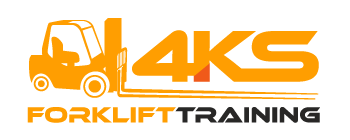How to pick up a load at ground level using Counterbalance
In this forklift training explainer video above, our instructor demonstrates how to safely pick up a load at ground level using the counterbalance forklift truck. This is a common truck for Novice (beginner) counterbalance forklift training.
Approaching a load and stopping 6 inches away using the correct method of picking the load up.
To avoid incidents while approaching the load, follow these requirements and recommendations:
- Always approach the load slowly and carefully
- Stop 6 inches in front of the load
- Make sure the truck is placed squarely in front of the load
- Make sure the forks are at the correct height for lifting the load
- Set the direction control to neutral
- Never raise or lower the forks unless the forklift is stopped and the brake is set
- Before raising the load, make sure there’s enough overhead clearance. Your vision can be blocked after the load is elevated.
- Use the inching pedal to creep the load to the stack.
Mast Position
The mast is the part of the forklift in the front that the actual forklifts ride up and down on.
While you’re moving the mast, take care to avoid tipovers and dropped loads.
To do so, follow these requirements and recommendations:
- Always use caution when using the mast to tilt loads
- Never tilt the mast forward with forks elevated unless you are picking up a load or putting down a load
- When stacking or tiering materials, tilt the mast backward only enough to stabilize the load and no more
- When handling loads that are close to the trucks’ maximum load capacity, be cautious, tilt the mast back and position the heaviest part of the load against the carriage, and travel with the mast tilted back to keep the load stable
- Use caution when tilting the mast forward while positioning the load onto the stack
- Never travel on a forklift with the load tilted forward. This increases the load distance and destabilizes the load.
Steps on How to pick up a load Counterbalance
- Follow the correct procedure to move off; Gear, Observation, Handbrake release and final Observation (GOBO).
- Looking at the direction of travel drive forward at a slow steady speed.
- Once you have arrived at your destination or location, stop 6 inches away from the allocated location.
- Apply handbrake and put the transmission into neutral.
- Ensure the mast is at a vertical position and your fork arms are level.
- Raise your forks to the required height to ensure you have a clean entry into the load/ pallet.
- Slowly move forward entering the load ensuring the fork arms are not grazing the top or bottom of the pallet.
- Drive forward until the load is at the back heel of the forks.
- Apply handbrake and put the transmission into neutral.
- Gently raise the load up.
- Transmission into reverse (backwards), we repeat the GOBO procedure Gear, Observation, Handbrake release and final Observation.
- Hand behind your seat,
- Twisting your body looking at the direction of travel giving you a clear visibility
- Keeping all limbs within the confines of the truck • Gently accelerate and reverse backwards at a very slow speed,
- 80% looking at the direction of travel and 20% looking at the load ensuring the load is not hitting or grazing any obstacles
- Once you’ve picked the load, stop 6 inches away
- Apply handbrake and transmission into neutral
- Lift your forks 4-6 inches off the ground and apply sufficient tilt and then go back to the GOBO procedure and reverse back to your destination.
4KS Forklift Training Ltd provides RTITB accredited forklift truck training at both our fully approved and accredited training centres in Birmingham and Peterborough.
For more information on the best counterbalance forklift training or to book your course today, call us:
Related Posts
Comments
Sorry, the comment form is closed at this time.






Jake Colton
I found this very useful. Thank you